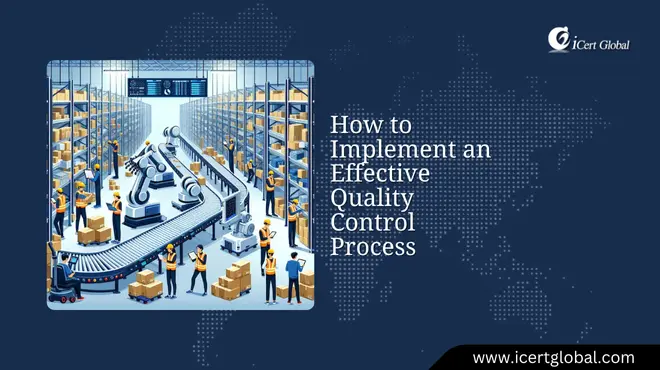1. COURSE OVERVIEW
1.1. Objectives
1.2. WHAT IS LEAN SIX SIGMA?
1.3. WHAT IS LEAN SIX SIGMA?
1.4. About ICERTGLOBAL'S LSSGB Course
2. Target Audience and Course Prerequisites
2.1. Benefits of LSSGB for Professionals
2.2. Benefits of LSSGB for Organizations
2.3. Lean Six Sigma Green Belt Exam Pattern
2.4. Lean Six Sigma Green Belt Exam
3. LESSON III: INTRODUCTION TO SIX SIGMA
3.1. Agenda
3.2. Basics of Six Sigma
3.3. Process for Six Sigma is DMAIC:
3.4. DMAIC Tools
3.5. What is Six Sigma?
3.6. Six Sigma Level Chart
3.7. Six Sigma --- Introduction to Qualifications
3.8. Why Six Sigma?
3.9. How Does Six Sigma work?
3.10. Six Sigma and Quality
3.11. From Where Does Six Sigma Come?
3.12. History of Six Sigma
3.13. Six Sigma and Business System
3.14. Lesson III: Lean Principles
3.15. Agenda
3.16. What is Lean?
3.17. Why Use Lean?
3.18. History of Lean
3.19. Other Lean Wastes
3.20. Examples of Waste
3.21. Lean Concepts
3.22. Lean Techniques
3.23. Cycle Time Reduction
3.24. The Theory Of Constraints
4. LESSON IV: DEFINE
4.1. Introduction
4.2. Prerequisites of a Six Sigma Project
4.3. Introduction to Define Phase
4.5. What is a Business Process?
4.6. Process Elements
4.7. Steps In Process
4.9. SIPOC Template
4.10. Sample SIPOC
4.11. SIPOC Notes
4.12. Owners and Stakeholders
4.13. Business - Stakeholder Relationship
4.14. Identify Customer
4.15. Internal Customers
4.16. External Customers
4.17. Collect Customer Data
4.18. Ways To Capture Customer Feedback
4.19. Examples How to Collect Customer data 66
4.20. Analyze Customer Requirements
4.21. Analyze Customer Requirements - Pareto Diagram
4.22. Pareto Chart --- An example
4.23. Pareto Chart --- An example
4.24. Pareto Chart --- An example
4.25. Pareto Chart --- Interpretation
4.26. Translate Customer Requirements
4.27. Translate Customer Requirements
4.28. Define CTQ
4.29. VOC - CTQ --- An Example
4.30. VOC - CTQ --- An Example
4.31. Translation Worksheet to Define CTQs
4.32. Translating Customer Requirements - QFD
4.33. QFD-An Automobile Bumper
4.34. QFD-An Automobile Bumper
4.35. QFD-An Automobile Bumper
4.36. QFD-An Automobile Bumper
4.37. QFD-An Automobile Bumper
4.38. Sample QFD Template
4.39. Agenda 84
4.40. Problem Statement
4.41. IS/IS NOT Template
4.42. IS/IS NOT Template - Example
4.43. Project Charter
4.44. Project Objective Criteria
4.45. Project Charter Sections
4.46. Sample Project Charter
4.48. Project Plan
4.49. Project Scope
4.50. Techniques for Identifying Project Scope
4.51. Project Primary Metrics 93
4.52. Secondary Project Metrics
4.53. Project Planning Tools
4.54. Network Diagrams
4.55. Project Planning Tool - Critical Path Method
4.56. Project Planning Tool - PERT
4.57. Project Planning Tool - Gantt Chart
4.58. Project Planning Tool - Work Breakdown Structure
4.59. Project Documentation
4.60. Vehicles for Project Documentation
4.61. Project Risk Management
4.62. Importance of Risk Analysis
4.63. Project Closure
4.64. Team Tools - Multi - voting
4.65. Team Tools - Brainstorming
4.66. Team Tools - Nominal Group Technique
4.67. Affinity Diagrams
4.68. Example: Brainstorming session
4.69. Tree Diagrams
4.70. Prioritization Matrices
4.71. Prioritization Matrices - Example
4.72. Process Decision Program Chart (PDPC)
4.73. Process Decision Program Chart (PDPC)
4.74. Activity Network Diagram
4.75. Activity Network Diagram
4.76. Defect Per Unit (DPU)
4.77. Rolled Throughput Yield (RTY)
4.78. Rolled Throughput Yield --- An Example
4.79. Rolled Throughput Yield --- An Example
4.80. Cost of Poor Quality (COPQ)
4.81. Defect Per Million Opportunities
4.82. Process Capability Indices
4.83. Process Capability Indices - Example
4.84. Process Capability Indices - Example
4.85. Failure Modes and Effects Analysis
4.86. Risk Priority Number (RPN) & Scale Criteria
4.87. Risk Priority Number (RPN) & Scale Criteria
4.88. Occurrence
4.89. Detection
4.90. Example Of FMEA & RPN
4.91. Team Stages
4.92. Team Tools - Multi - voting
4.93. Group Challenges
4.94. Six Sigma Teams and Other Responsibilities
4.95. Six Sigma Teams and Other Responsibilities
4.96. Communication Technique
4.97. Communication Techniques
5. LESSON V: MEASURE
5.1. Agenda
5.2. Introduction to Measure Phase
5.3. Process Modeling
5.4. Common Symbols Of Flowchart:
5.5. Flowchart
5.6. Written Procedures
5.7. Work Instruction
5.8. Work Instruction - Example
5.9. Cause and Effect Matrix
5.10. Cause and Effect Matrix Template
5.12. Cause and Effect Matrix: How to update
5.13. Cause and Effect Diagram
5.14. Cause and Effect Diagram - Example
5.15. Analytical Statistics: Introduction to Hypothesis
5.16. Analytical Studies
5.17. Analytical Statistics
5.18. Enumerative Statistics
5.19. Central Limit Theorem
5.20. Central Limit Theorem: Graphical
5.21. Central Limit Theorem and Sampling Distribution of the Mean 1
5.22. Basic Probability Concepts
5.23. Basic Properties of Probabilities
5.24. Probabilities: Example
5.25. Basic Properties of Probabilities, cont..
5.26. Various Probability Rule
5.27. Addition Rule
5.28. Addition Rule, cont:
5.29. Multiplication Rule
5.30. Multiplication Rule, cont:
5.31. Multiplication Rule, cont:
5.32. Types of Data
5.33. Types of Data
5.34. Measurement Scales
5.35. Data Collection Methods
5.36. Techniques for Assuring Data Accuracy
5.37. Simple Random Sampling versus Stratified Sampling
5.38. Descriptive Statistics-1 1
5.39. Descriptive Statistics - I, cont:
5.40. Descriptive Statistics - 2
5.41. Variance
5.42. Standard Deviation
5.43. Descriptive Statistics - 3
5.44. Descriptive Statistics - 3, cont:
5.45. Descriptive Statistics - 4
5.46. Descriptive Statistics - 4, cont:
5.47. Descriptive Statistics - 5
5.48. Graphical Method
5.49. Box and Whisker Plots
5.50. Run Charts
5.51. Scatter Plots
5.52. Pareto Charts
5.53. Normal Probability Plots
5.54. Normal Probability Plots, cont.:
5.55. Discrete Probability Distribution
5.56. Binomial Distribution
5.57. Binomial Distribution, cont..
5.58. Binomial Distribution - Concepts
5.59. Defectives and Defects
5.60. Poisson Distribution
5.61. Poisson Distribution - Characteristics
5.62. Poisson Distribution - An Example
5.63. Continuous Distribution - Normal Distribution
5.64. Normal Distribution - Characteristics
5.65. Normal Distribution - Characteristics, cont..
5.66. Long Term v/s Short Term
5.67. Z-table Usage
5.68. Z-table Usage, cont..
5.69. Normal Distribution, cont..
5.70. Chi Square Distribution 5.71. Chi Square Test - Example
5.72. Chi Square Test - Example, cont:
5.73. t - Distribution
5.74. f - Distribution: Characteristics
5.75. Measurement System Analysis
5.76. Objective of Measurement System Analysis
5.77. Measurement System Analysis
5.78. Sources of Variation
5.79. Gage Repeatability and Reproducibility
5.80. Component of GRR Study
5.81. Key Concepts
5.82. Measurement Resolution
5.83. Repeatability and Reproducibility
5.84. Repeatability and Reproducibility
5.85. Data Collection
5.86. GAGE RR Template
5.87. GAGE RR Results Summary
5.88. GAGE RR Interpretation 235
5.89. Process Stability Studies 236
5.90. Process Stability Studies 237
5.91. Process Stability Studies 238
5.92. Process Capability Studies - 1
5.93. Process Capability Studies - 2
5.94. Process Capability Studies - 3
5.96. Process Performances vs. Specification
5.97. Process Performance Indices
5.98. Process Performance Indices - contd
5.99. Process Performance Indices - contd
5.100. Short-term vs. Long-term capability
5.101. Assumptions and Convention - Process Variations
5.102. Stability, Capability, Spread and Defects Summary
5.103. Cpk versus Cp Comparison
5.104. Understanding Process Variations - Complaint Resolution Time Hours
5.105. Understanding Process Variations
5.106. Effect of Mean Shift
5.107. Process Capability for attributes data
5.108. Understanding Process Variations - Quality Control Department
Example
5.109. Understanding Process Variations - Quality Control Department
Example, contd..
6. LESSON VI: ANALYZE
6.1. Agenda
6.2. Causes for Variations in X
6.3. Causes of Variation - Examples
6.4. Analysis, cont:
6.5. Create Multi-Vari Chart
6.6. Create Multi-Vari Chart
6.7. Create Multi-Vari
6.8. Correlation Levels
6.9. Regression
6.10. Key Concepts
6.11. Simple Linear Regression (SLR)
6.12. Least Squares Method in SLR (Simple Linear Regression)
6.13. Simple Linear Regression - Example
6.14. SLR Using Excel,
6.15. SLR Using Excel, cont..
6.16. SLR Using Excel
6.17. Multiple Linear Regression
6.18. Key Concepts
6.19. Key Concepts, cont:
6.20. Statistical and Practical Significance of Hypothesis Test
6.21. Hypothesis
6.22. Type I Error
6.23. Type II Error
6.24. Type I and Type II Errors - Key Concepts
6.25. Power of Test
6.26. Determinants of Sample Size - Continuous Data
6.27. Standard Sample Size Formula - Continuous Data
6.28. Standard Sample Size Formula - Discrete Data
6.29. Hypothesis Testing Roadmap
6.30. Hypothesis Test for Means (Theoretical)
6.31. Hypothesis Test for Variance and Proportions
6.32. Comparison of Means of Two Processes
6.33. Paired Comparison Hypothesis Test for Means (Theoretical)
6.34. Paired-Comparison Hypothesis Test for Variance - F-Test example
6.35. Hypothesis Test for Equality of Variance - F-Test Example
6.36. Hypothesis Tests (Practical)
6.37. F-Test
6.38. F-Test
6.39. F-Test Assumptions
6.40. F-Test Interpretations
6.41. Hypothesis Tests (Practical)
6.42. 2-Sample t-Test
6.43. 2-Sample Independent t-Test Assumptions
6.44. 2-Sample Independent t-Test
6.46. Paired t-Test
6.47. ANOVA (Comparison of More Than Two Means)
6.48. ANOVA (Comparison of More Than Two Means)
6.49. ANOVA - Example
6.50. Using Minitab for ANOVA
6.51. Using Minitab for ANOVA, cont..
6.52. ANOVA using Excel
6.53. Interpreting Minitab Results
6.54. Chi - Square Test
6.55. Hypothesis Tests -- Summary points
7. LESSON VII: IMPROVE
7.1. Agenda
7.3. Introduction to Improve and Control
7.5. Piloting
7.6. Piloting
7.7. Piloting
7.8. Piloting
7.9. Design of Experiments - An Introduction 323
7.10. Basic Terms - 1
7.11. Basic Terms - 2
7.12. Basic Terms - 3
7.13. DOE - A Plastic Molding Example
7.14. Components of DOE in the Molding Example
7.15. Full Factorial Experiment -Example
7.16. Full Factorial Experiment -Example
7.17. Main Effect
7.18. Interaction Effect
7.19. Design of Experiments - Runs
7.20. Design of Experiments --- Which Experimental Method?
7.21. Objectives & Benefits of SPC 3
8. LESSON VIII: CONTROL
8.1. Basics of Control Charts
8.2. Setting the Control Limits
8.3. Purpose of Control Limits
8.4. Most Common Rules for Control Chart Analysis
8.5. Choosing an Appropriate Control Chart -Continuous Data
8.6. Choosing an Appropriate Control Chart - Discrete Data
8.7. Xbar Chart Principles
8.8. Defining the Xbar-R UCL and LCL
8.9. Xbar-R and Subgroup Data - Example
8.10. Constructing/Analyzing an Xbar-R Chart Graph -Example
8.11. I-MR Chart Principles
8.12. I-MR and Individual Data - Example
8.13. Constructing an I-MR Chart Graph -Example
8.14. Control Charts for Attribute Data
8.15. np-chart Principles
8.16. np-charts and Uniform Subgroup Size -Example
8.17. Constructing/Analyzing an np-chart Graph -Example
8.18. p-chart Principles
8.19. p-charts and Varying Subgroup Size -Example
8.20. Constructing/Analyzing a p-chart Graph -Example
8.21. c-Chart Principles
8.22. c-Chart Subgroups - Example
8.23. Constructing/Analyzing a p-chart Graph -Example
8.24. u-Chart Principles
8.25. u-Chart Subgroups
8.26. Constructing a u-Chart Graph
8.27. New Process Capability
8.28. Measurement System Reanalysis
8.29. What is a Control Plan?
8.30. Control Plan Strategy
8.31. What to Control?
8.32. Identifying KPIVs
8.33. Control Plan Tools
8.34. Developing a Control Plan
8.35. Choosing the Right Level of Control
8.36. Example of Transactional Control Plan
8.37. Process Step
8.38. Characteristic/Parameter
8.39. Specification/Requirement
8.40. Sample Size - Frequency - Who Measures
8.41. Where Recorded?
8.42. Decision Rule/Corrective Action
8.43. Reference Number
8.44. Sample Manufacturing Control Plan
8.45. Summary - Control Phase Key Objectives and Tasks




























